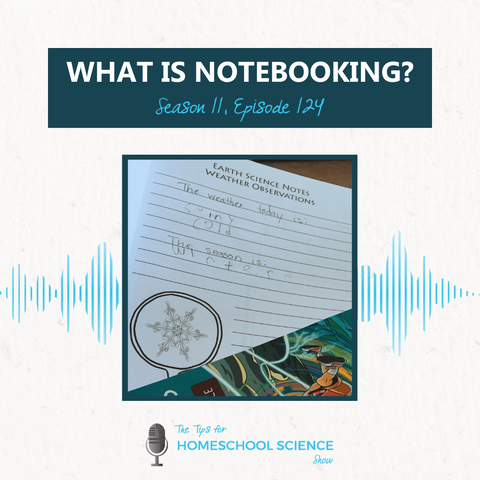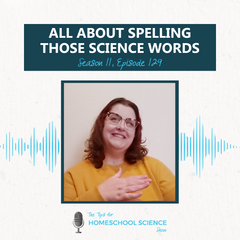FREE Shipping on all our products! (Please Note: Orders may experience a delay of a week or more in shipping due to the high volume of orders at this time of year.)
FREE Shipping on all our products! (Please Note: Orders may experience a delay of a week or more in shipping due to the high volume of orders at this time of year.)
What is notebooking? {Season 11, Episode 124}
February 19, 2024 4 min read

Season 11 of the Tips for Homeschool Science podcast is here! This season will be all about writing and science.
In this episode, we'll be discussing what notebooking is and how you can use this tool for science in your homeschool.
Key Takeaway
-
Notebooking is the best method of writing for science!
Listen to this episode
You can also listen to this podcast on iTunes, Podcast Addict, Castbox, Stitcher, or Spotify.
Share the Tips
If you found these homeschool science tips to be helpful, would you please take a moment to rate it in the podcasting app you use to listen to the show? This would help me tremendously in getting the word out so that more earbuds are filled with science-teaching encouragement.
Episode 124 - What is notebooking?
We’re back with new episodes and for the eleventh season of the Tips for Homeschool Science Show. In this season, we are talking about writing and science. I’ve gotten a lot of questions lately about lapbooks, notebooks, and what to expect, so I thought it was time to dedicate an entire season to the third key to teaching science—writing it down.
What Season 11 is going to look like (01:05)
We’ll start this season with a look at the our favorite method of writing for science—notebooking. I had never heard of this before I started homeschooling, but I have absolutely grown to love this tool and have seen the benefits of using it over the long haul.
After that, we’ll chat about lapbooks and notebooking pages, including how to decide which one is right for your homeschool. Then, we’ll answer some of the most common questions we get about writing and science. We’ll sprinkle a few guests into the season as well so that you can meet some of the voices that have helped me learn about writing over the years.
Sound good?
Great, let’s begin with a look at notebooking!
Why notebooking is the best method for writing in science (01:46)
As I said, I had no idea what notebooking was before we started homeschooling. In fact, I was one of those unicorn students who actually liked worksheets. Maybe it was the fact that my mom was a teacher, or maybe it was because I clearly knew what was required in my response.
I still appreciate worksheets as they have their place, but I have fallen in love with notebooking. I now understand how valuable it is to have a student narrate rather than respond with expected facts.
There are no canned responses in notebooking. There are no blanks to fill in. There are no answers to match up. Instead, the students need to mull over what they just read to formulate a summary of what they learned. In short, notebooking requires that the students engage with the material before they write down a word.
And I know from experience that students are more likely to remember what they find meaningful. If they write it down, the chance of them internalizing this material goes up exponentially. Notebooking allows the freedom for the student to write down the most interesting and meaningful facts they found in what they read.
The Two Components of Notebooking (03:24)
Notebooking has two key components - the material content and the visual component. The material content is what the students write, while the visual component is a picture that relates to the topic. The two pieces stimulate different parts of the brain, which helps to solidify the information in their minds.
The material component of notebooking (03:50)
The material component of notebooking contains the information the students have learned. It should contain:
- A record of what the students find to be meaningful;
- Or documentation of what you would like for the students to remember.
You can obtain this information from the students by asking open-ended questions like:
- What did you find interesting about what we just read?
- What do you remember from what we just studied?
These questions will help the students formulate a record of what they found to be meaningful.
If you want the students to document specific information, you can ask them leading questions. These answers will help them to plan out the desired response before they write it down on their notebooking page.
Essentially, the material component is a written record of the facts the students have studied.
The visual component of notebooking (05:16)
The visual component of notebooking displays a picture of the concept the students have studied.
The students can:
- Print out an actual picture;
- Make their own copy of a real-life photo;
- Or draw their own version.
They can look at the internet or in encyclopedias for these images. The key is to have the students use an illustration that relates to the information they have written down.
At its core, the visual component is a visible representation of the information the students have learned.
Wrapping it up (06:41)
The wonderful thing about homeschooling is that we have so many options. We can pick the tool that works best for our kids and notebooking is flexible enough to make this possible. You can arrange the two components of notebooking in many different ways. You can create notebooking pages, lapbooks, booklets, posters, and more. However you choose to use notebooking in your homeschooling, the material and visual components will help to solidify the information in the students' minds. Thanks for listening and I hope you have a great week playing with science!
How we can help you with science
Did you know that all our programs at Elemental Science use notebooking? And many of those have both a lapbook and a notebook option.
If you are looking for a science unit with both a lapbook and a notebook, you’ll want to check out our Science Chunks series. This series puts you in charge of your science studies for the year. You can pick and choose the units that interest you. Plus with two levels reading and writing, you can incorporate the whole family.
Also in {Podcast} The Tips for Homeschool Science Show
All About Spelling Those Science Words {Season 11, Episode 129}
March 25, 2024 7 min read

In this episode, we'll be interviewing Robin Williams from All About Spelling. Click "Read More" to listen is as we discuss tips and tricks for spelling all those science words!
How should you handle notebooking through the different ages? {Season 11, Episode 128}
March 18, 2024 3 min read

Writing in Science with a Well-Trained Mind (Interview) {Season 11, Episode 127}
March 11, 2024 16 min read

Click "Read More" to listen in as Susan Wise Bauer and Susanna Jarret join Paige to share tips and tools about the third key to teaching science!
Subscribe
Sign up to get the latest on sales, new releases and more …

